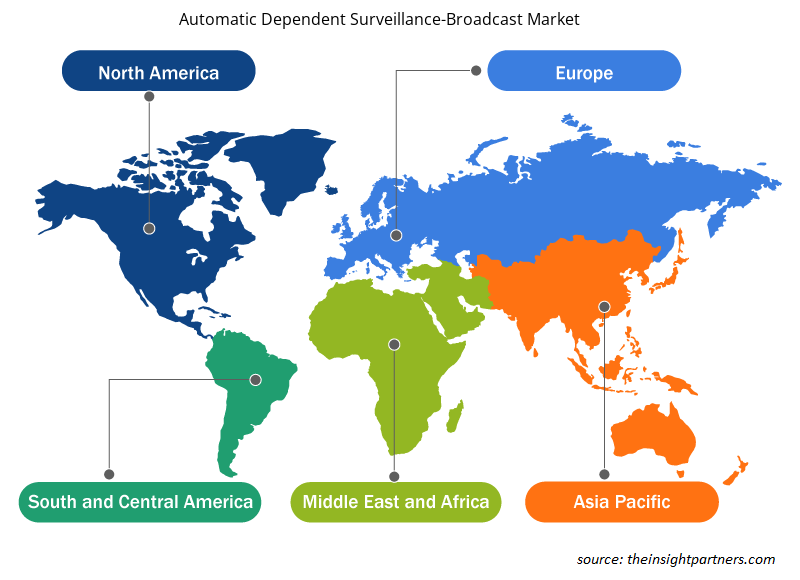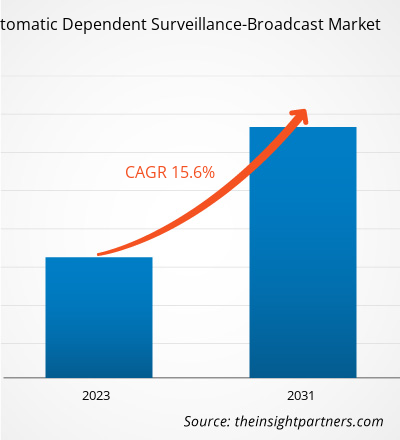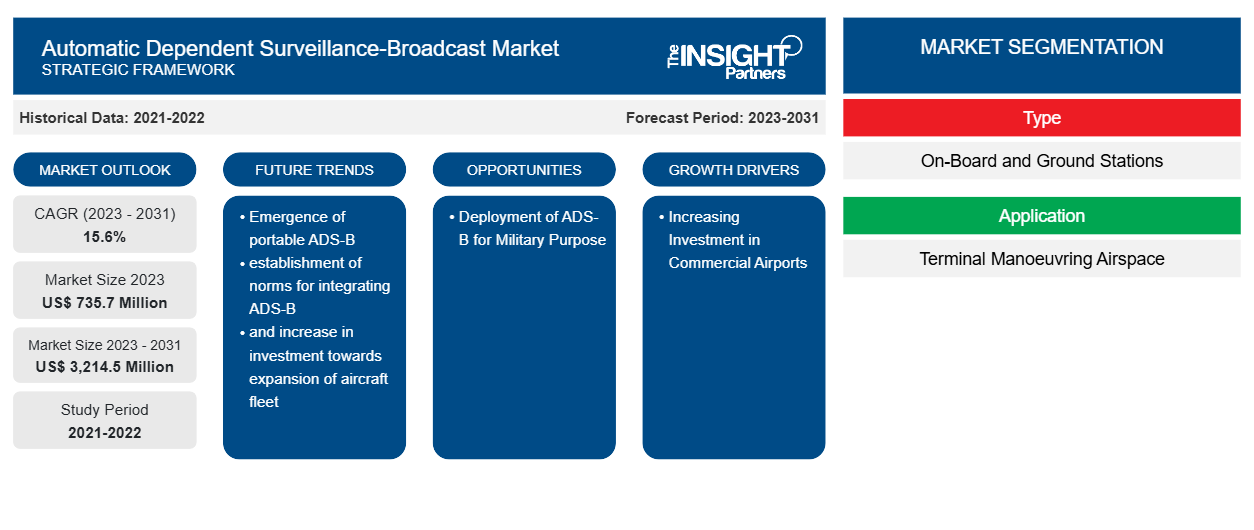Français La taille du marché de la surveillance dépendante automatique en mode diffusion devrait atteindre 3 214,5 millions USD d'ici 2031, contre 735,7 millions USD en 2023. Le marché devrait enregistrer un TCAC de 15,6 % en 2023-2031. L'émergence de l'ADS-B portable, l'établissement de normes pour l'intégration de l'ADS-B et l'augmentation des investissements en vue de l'expansion de la flotte d'aéronefs font partie des principales tendances qui stimulent le marché de la surveillance dépendante automatique en mode diffusion.
Surveillance dépendante automatique – Analyse du marché de la diffusion
Le nombre croissant de commandes et de livraisons de flottes d'avions à travers le monde, associé aux mandats d'utilisation de l'ADS-B, joue un rôle positif dans la stimulation de l'adoption de l'ADS-B. En outre, l'augmentation des investissements pour moderniser les aéroports commerciaux avec des installations et des technologies de pointe devrait favoriser l'adoption de l'ADS-B. En outre, les projets approuvés par les autorités aéronautiques de pays tels que les États-Unis pour l'utilisation de l'ADS-B dans des applications militaires devraient offrir de nombreuses opportunités de croissance aux fabricants d'ADS-B au cours de la période de prévision. En outre, l'émergence de l'ADS-B portable pour économiser le coût de fabrication et d'installation de l'ADS-B standard devrait contribuer à la croissance du marché.
Aperçu du marché de la surveillance dépendante automatique – diffusion
L'ADS-B est une technique de surveillance qui ne nécessite aucun stimulus externe. Cette technique dépend des véhicules et des avions de l'aéroport pour diffuser leur position, leur identité et d'autres informations obtenues à partir de systèmes embarqués comme le GNSS. L'ADS-B présente des caractéristiques telles que des performances élevées, une durabilité environnementale, une interopérabilité mondiale, une capacité accrue et une sécurité améliorée. De plus, l'infrastructure de surveillance ADS-B est moins coûteuse que la technologie radar primaire , ce qui la rend rentable à des fins de surveillance. Une augmentation des investissements dans l'expansion des flottes d'avions à travers le monde devrait stimuler la croissance du marché de la surveillance dépendante automatique-diffusion au cours de la période de prévision. En outre, l'aviation commerciale devrait augmenter dans les années à venir en raison du nombre croissant de voyageurs aériens et de l'acquisition de nouveaux avions. En Amérique du Nord, en Europe et dans la région Asie-Pacifique, le trafic aérien de passagers augmente avec le temps, ce qui alimente la demande d'avions commerciaux. En Asie-Pacifique, principalement en Chine et en Inde, les avions commerciaux pour les voyages intérieurs se sont avérés rentables. Cela devrait alimenter la croissance du marché dans les années à venir.
Personnalisez ce rapport en fonction de vos besoins
Vous bénéficierez d'une personnalisation gratuite de n'importe quel rapport, y compris de certaines parties de ce rapport, d'une analyse au niveau des pays, d'un pack de données Excel, ainsi que de superbes offres et réductions pour les start-ups et les universités.
-
Obtenez les principales tendances clés du marché de ce rapport.Cet échantillon GRATUIT comprendra une analyse de données, allant des tendances du marché aux estimations et prévisions.
Surveillance dépendante automatique : moteurs et opportunités du marché de la diffusion
Augmentation des investissements dans les aéroports commerciaux
Français Avec l'augmentation du nombre d'aéroports commerciaux dans le monde, l'adoption de l'ADS-B augmente également. Cette technologie est actuellement mise en œuvre dans des régions telles que l'Europe, l'Amérique du Nord et l'Asie. Avec l'augmentation des infrastructures des aéroports commerciaux ou la rénovation des aéroports existants, le nombre d'équipements au sol, tels que les terminaux ATC, augmente également, tirant ainsi parti de l'ADS-B pour le suivi des avions. Dans des pays comme la Chine, l'aéroport international de Chongqing Jiangbei (CQIA) est l'un des 10 plus grands aéroports, qui fait l'objet d'un plan d'expansion important. Grâce aux investissements, l'aéroport doit recevoir le statut de plaque tournante aérienne internationale et sera le plus grand de l'ouest de la Chine d'ici 2035. Un autre aéroport en Chine qui connaît des investissements pour développer un aéroport est l'aéroport international de Pékin Daxing.ATC terminals, is also increasing, thus taking advantage of ADS-B for tracking aircraft. In countries such as China, Chongqing Jiangbei International Airport (CQIA) is among the 10th largest airports, which is undergoing a significant expansion plan. From investment, the airport is to receive international air hub status and will be the largest in western China by 2035. Another airport in China witnessing investment to develop an airport is Beijing Daxing International Airport.
SE Lithuanian Airports a signé un accord de prêt d'une valeur de 81 millions USD (70 millions EUR) avec la Banque nordique d'investissement pour moderniser les trois principaux aéroports de Lituanie : Vilnius, Kaunas et Palanga. De tels projets liés à la modernisation des aéroports devraient favoriser l'adoption de technologies avancées, notamment l'ADS-B. Les données suivantes représentent les investissements en termes de construction/mise à niveau/modernisation d'aéroports dans des régions telles que l'Amérique du Nord, qui devrait atteindre 20 milliards USD, l'APAC, 90,86 milliards USD, SAM, 1,12 milliard USD et MEA, 42,92 milliards USD pour le développement de leurs aéroports.Palanga. Such projects related to the modernization of airports are projected to propel the adoption of advanced technologies, including ADS-B. The following data represents the investments in terms of constructing/upgrading/modernizing airports across regions such as North America to witness US$ 20 billion, APAC to see US$ 90.86 billion, SAM to experience US$ 1.12 billion, and MEA to US$ 42.92 billion for the development of their airports.
Les investissements mentionnés pour la construction de nouveaux aéroports et la modernisation des aéroports existants devraient accroître le déploiement de techniques de surveillance avancées pour mieux suivre les avions . Ainsi, ils contribuent positivement au déploiement de l'ADS-B, qui stimule le marché de la surveillance dépendante automatique par diffusion.
Déploiement de l'ADS-B à des fins militaires
Français La portée de l'ADS-B s'élargit pour assurer le suivi précis des avions. Avec les progrès technologiques continus, l'intégration de l'ADS-B augmente parmi les avions militaires. Selon l'US Air Force, le Pentagone devrait avoir 2 936 avions équipés de l'ADS-B Out guidé par le mandat de la FAA. D'ici 2025, le DoD américain vise à avoir près de 62 % de ses avions équipés de l'ADS-B (Out), dont plus de 67 % des hélicoptères, 35 % des avions de chasse et 100 % des avions de mobilité, d'entraînement, de commandement et de contrôle/renseignement, de surveillance et de reconnaissance (C2/ISR). Près de 1 129 hélicoptères, 259 avions C2/ISR, 923 avions de mobilité et 625 avions d'entraînement devraient être équipés de l'ADS-B selon l'Air Force. Au sein du Département de la Défense, les avions qui devraient bénéficier de l'ADS-B comprennent les Boeing C-17 Globemaster, les hélicoptères Lockheed Martin UH-60 Black Hawk, les C-130 et les avions de transport C-5. Un déploiement aussi massif de l'ADS-B dans l'aviation militaire devrait influencer efficacement la croissance du marché de la surveillance dépendante automatique en mode diffusion.
Analyse de segmentation du rapport sur le marché de la surveillance dépendante automatique en diffusion
Les segments clés qui ont contribué à l’élaboration de l’analyse du marché de la surveillance dépendante automatique en diffusion sont le type et l’utilisateur final.
- En fonction du type, le marché de la surveillance dépendante automatique en diffusion a été divisé en stations embarquées et stations au sol. Le segment des stations embarquées détenait une part de marché plus importante en 2023.
- En fonction de l'application, le marché de la surveillance dépendante automatique et de la diffusion a été divisé en surveillance de l'espace aérien de manœuvre terminal (TMA) et surveillance aéroportée. Le segment de la surveillance aéroportée détenait une part de marché plus importante en 2023.
- Sur la base des composants, le marché a été segmenté en antenne, récepteur, transpondeur et récepteurs terrestres ADS-B. Le segment des transpondeurs a dominé le marché en 2023.
Analyse des parts de marché de la surveillance dépendante automatique par zone géographique
La portée géographique du rapport sur le marché de la surveillance automatique dépendante-diffusion est principalement divisée en cinq régions : Amérique du Nord, Europe, Asie-Pacifique, Moyen-Orient et Afrique et Amérique du Sud.
L'Amérique du Nord a dominé le marché de la surveillance dépendante automatique en 2023. L'Amérique du Nord est la région la plus avancée technologiquement, avec des économies majeures comme les États-Unis, le Canada et le Mexique. Ces économies sont classées en fonction de niveaux de vie plus élevés, de revenus individuels disponibles élevés et de progrès technologiques rapides dans l'ingénierie aérospatiale et la construction d'aéroports. La région Amérique du Nord comprend la plus grande flotte d'avions commerciaux et de défense au monde. Le grand nombre de flottes commerciales et militaires opérationnelles sur la scène nationale et internationale, associé à une valeur moyenne élevée du nombre de passagers-kilomètres parcourus dans la région, a alimenté la demande de composants de communication pour les aéroports et les avions. Les économies de la région ont une présence considérable d'aéroports commerciaux et militaires. Certaines mettent à niveau l'ADS-B et les systèmes associés dans ces sites aéroportuaires pour les applications de réception de signaux au sol et dans les avions.
Aperçu régional du marché de la surveillance dépendante automatique
Les tendances et facteurs régionaux influençant le marché de la surveillance dépendante automatique en diffusion tout au long de la période de prévision ont été expliqués en détail par les analystes d’Insight Partners. Cette section traite également des segments et de la géographie du marché de la surveillance dépendante automatique en diffusion en Amérique du Nord, en Europe, en Asie-Pacifique, au Moyen-Orient et en Afrique, ainsi qu’en Amérique du Sud et en Amérique centrale.

- Obtenez les données régionales spécifiques au marché de la surveillance dépendante automatique - diffusion
Portée du rapport sur le marché de la surveillance dépendante automatique – diffusion
| Attribut de rapport | Détails |
|---|---|
| Taille du marché en 2023 | 735,7 millions de dollars américains |
| Taille du marché d'ici 2031 | 3 214,5 millions de dollars américains |
| Taux de croissance annuel composé mondial (2023-2031) | 15,6% |
| Données historiques | 2021-2022 |
| Période de prévision | 2023-2031 |
| Segments couverts |
Par type
|
| Régions et pays couverts |
Amérique du Nord
|
| Leaders du marché et profils d'entreprises clés |
|
Densité des acteurs du marché : comprendre son impact sur la dynamique des entreprises
Le marché de la surveillance dépendante automatique en diffusion connaît une croissance rapide, tirée par la demande croissante des utilisateurs finaux en raison de facteurs tels que l'évolution des préférences des consommateurs, les avancées technologiques et une plus grande sensibilisation aux avantages du produit. À mesure que la demande augmente, les entreprises élargissent leurs offres, innovent pour répondre aux besoins des consommateurs et capitalisent sur les tendances émergentes, ce qui alimente davantage la croissance du marché.
La densité des acteurs du marché fait référence à la répartition des entreprises ou des sociétés opérant sur un marché ou un secteur particulier. Elle indique le nombre de concurrents (acteurs du marché) présents sur un marché donné par rapport à sa taille ou à sa valeur marchande totale.
Les principales entreprises opérant sur le marché de la surveillance dépendante automatique en diffusion sont :
- Société Avidyne
- Aspen Avionique, Inc.
- Collins Aérospatiale
- Systèmes FreeFlight
- Garmin Ltd
- Honeywell International Inc.
Avis de non-responsabilité : les sociétés répertoriées ci-dessus ne sont pas classées dans un ordre particulier.

- Obtenez un aperçu des principaux acteurs du marché de la surveillance dépendante automatique en diffusion
Surveillance dépendante automatique – Actualités du marché de la diffusion et développements récents
Le marché de la surveillance automatique dépendante-diffusion est évalué en collectant des données qualitatives et quantitatives après des recherches primaires et secondaires, qui comprennent d'importantes publications d'entreprise, des données d'association et des bases de données. Voici une liste des développements sur le marché de la surveillance automatique dépendante-diffusion et des stratégies :
- En juin 2023, Aireon et NAV Portugal ont lancé le système ADS-B basé dans l'espace. Grâce à ce système, plus de 75 % de l'espace aérien de la région nord de l'Atlantique de l'OACI est désormais contrôlé sur la base d'une surveillance du trafic aérien en temps réel.
- En novembre 2020, Aireon a conclu un partenariat avec la Federal Aviation Administration. Ce partenariat visait à explorer les données ADS-B spatiales et a ainsi renforcé la position de l'entreprise sur ce marché.
Rapport sur la couverture et les livrables du marché de la surveillance dépendante automatique
Le rapport « Taille et prévisions du marché de la surveillance dépendante automatique en diffusion (2021-2031) » fournit une analyse détaillée du marché couvrant les domaines ci-dessous :
- Taille du marché et prévisions aux niveaux mondial, régional et national pour tous les segments de marché clés couverts par le périmètre
- Dynamique du marché, comme les facteurs moteurs, les contraintes et les opportunités clés
- Principales tendances futures
- Analyse détaillée des cinq forces de Porter
- Analyse du marché mondial et régional couvrant les principales tendances du marché, les principaux acteurs, les réglementations et les développements récents du marché
- Analyse du paysage industriel et de la concurrence couvrant la concentration du marché, l'analyse de la carte thermique, les principaux acteurs et les développements récents
- Profils d'entreprise détaillés avec analyse SWOT
- Analyse historique (2 ans), année de base, prévision (7 ans) avec TCAC
- Analyse PEST et SWOT
- Taille du marché Valeur / Volume - Mondial, Régional, Pays
- Industrie et paysage concurrentiel
- Ensemble de données Excel
Rapports récents
Rapports connexes
Témoignages
Raison d'acheter
- Prise de décision éclairée
- Compréhension de la dynamique du marché
- Analyse concurrentielle
- Connaissances clients
- Prévisions de marché
- Atténuation des risques
- Planification stratégique
- Justification des investissements
- Identification des marchés émergents
- Amélioration des stratégies marketing
- Amélioration de l'efficacité opérationnelle
- Alignement sur les tendances réglementaires























 Obtenez un échantillon gratuit pour - Surveillance dépendante automatique - Marché de la radiodiffusion
Obtenez un échantillon gratuit pour - Surveillance dépendante automatique - Marché de la radiodiffusion